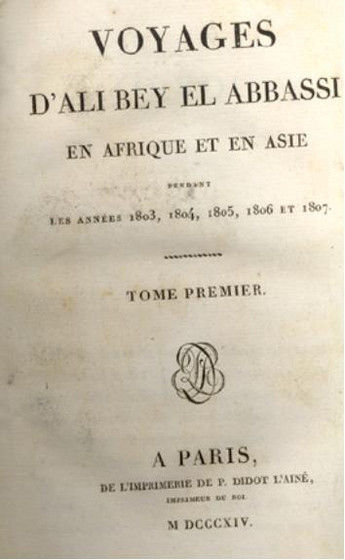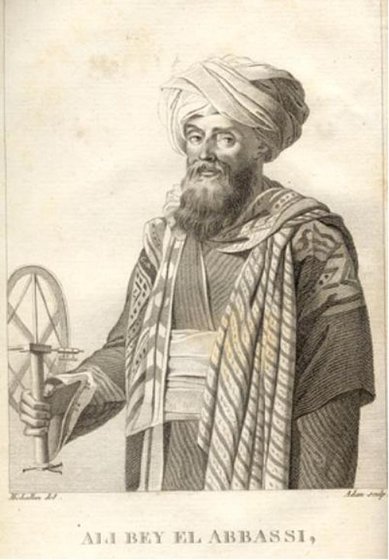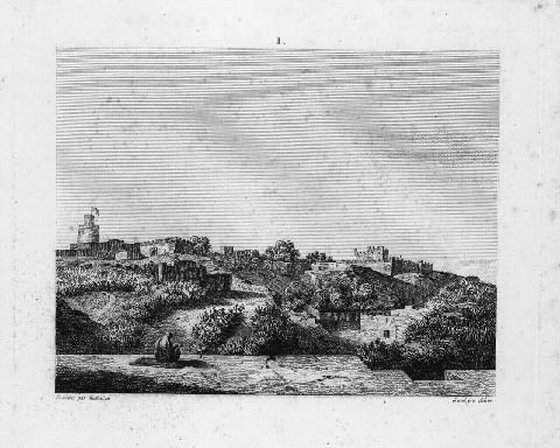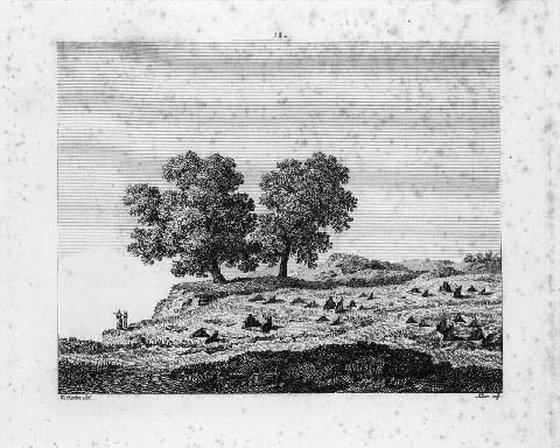VOYAGES D'ALI BEY EL ABBASSI EN AFRIQUE ET EN ASIE PENDANT LES ANNÉES 1803-1807
Ali Bei el Abassi (pseudonym of Domingo Badia y Leblich)
| Numéro d'objet: |
467 |
| Date: |
1814 |
| Genre: |
Livre |
| Lieu: |
Paris |
| Sujet: |
Voyages |
Recherche dans "Notes":
1814. Ali Bei el Abassi [pseudonym of Domingo Badia y Leblich, a Spanish traveller]. – Voyages en Afrique et en Asie pendant les années 1803-1807. Paris: 3 vol., 8vo, with atlas, 4to, Ixxxv. Plates, of which those from i. to xii.bis, relate to Morocco, and 3 maps.
An English version was published at London in 1816, 2 vol. 4to; a Spanish one in 1836, at Valencia, 3 vol. 8vo; and a second French edition at Paris, 1884, 3 vol. 12mo.
The author travelled (1805-6) as a Turk; he landed at Tangier, where he saw the Sultan, passed through Mekenes to Fez, returned to the coast at Rabat, going from thence to Merakish, where he remained for some months, being all the time treated with great magnificence; he returned to Fez, Ujdq, and El Araish (Larache), whence he embarked for Tripoli and the further East, including Mekka, which he duly reached. (Edinburgh Review, vol.xxiii p. 521.) In the introduction to the English edition full particulars are given of his visits to England, both before and after his memorable journeys. But the man's history is still a mystery. No one seems to have ascertained the source of the funds which he spent with princely magnificence. He pretended to be a native of Aleppo ; and was known as Sid Helebi – i.e. « the gentleman of Aleppo : » and it is thought that the Spanish Government supplied him with money, though what purpose they had in so doing is not quite clear. Latterly both the Sultan and the officials got suspicious of him, and the rumour spread qbroad that he was an agent of Bonaparte. Two renegades in his employ whispered that he had corns on his feet, excresences unknown to Moors, whose shoes are loose over the toes. The Emperor sent him wives, who were intended to spy upon him; and his departure from the Empire was closely akin to expulsion. Latterly, the absurd report circulated that he was actually Bonaparte himself, and for a time he was called « Parte; » for as « Bonna » signifies in the Lingua Franca « good », they would not designate him by a name which might imply that the Frankish conqueror was anything but a fiend. A son of his was living in Fez fifteen years after his departure. Some curious particulars about Ali Bei are given in Jackson's « Timbuctoo and Housa » (No.527), pp. 297-304.
voyage de Domingo Badia y Leblich alias Ali Bey, catalan haut en couleur, très cultivé, polyglotte, qui subjugua les grands savants de l'époque à Paris comme à Londres, et charma Chateaubriand lors de leur rencontre en Egypte. Il se déguisa en musulman, s'inventa une noble généalogie arabe et visita la Mecque cinquante ans avant Richard Burton. Sa notoriété au Maroc fut telle qu'il rêva un moment de devenir sultan
Voyages d'Ali Bey El Abbassi en Afrique et en Asie pendant les années 1803, 1804, 1805,1806 et 1807] / Michallon, Ali Bey, dess. ; Adam, grav. ; Domingo Badia y Leyblich, aut. du texte
Auteur : Michallon, Achille-Etna (1796-1822). Dessinateur
Auteur : Abassi, Ali Bey El. Dessinateur
Auteur : Adam, Jakob. Graveur
Auteur : Badia y Leyblich, Domingo. Auteur du texte
Éditeur : Didot (Paris)
Date d'édition : 1814
Sujet : Maroc -- Descriptions et voyages -- 19e siècle
Sujet : Moyen-Orient -- Descriptions et voyages -- 19e siècle
Sujet : Egypte -- Descriptions et voyages -- 19e siècle
Sujet : Istanbul (Turquie) -- Descriptions et voyages -- 19e siècle
Sujet : Grèce -- Descriptions et voyages -- 19e siècle
Type : image fixe
Langue : Français
Catalan scholar, French spy and linguist (1766[-]1818). Studied at Valencia; journeyed to London in 1802 to seek the endorsement of the African Association for the exploration of the interior of Morocco. Landed in Tangier in 1803 disguised as a Syrian prince of noble lineage and was received at the court of Moulay Sliman before progressing to Mecca. Returned to the court of Napoleon as General Badia. In 1818 he planned to reach Timbuktu by journeying with a caravan of returning pilgrims but died at Damascus en route to Mecca.
Historique:
L'ouvrage est constitué d'un volume et d'un Atlas. Le
Volume 1 comprend 1 frontispice. L'Atlas comprend
86 planches, dont une présentée en deux volets, la
plupart avec plusieurs images par planches, et 5 cartes
(1814). Réserve Bibliothèque Musée de l'Homme.
Musée de l'Homme
Autre(s) auteur(s) : Michallon, Achille-Etna (1796-1822). Dessinateur
Abassi, Ali Bey El. Dessinateur
Adam, Jakob. Graveur
Badia y Leyblich, Domingo. Auteur du texte
Sujet(s) : Maroc -- Descriptions et voyages
Moyen-Orient -- Descriptions et voyages
Egypte -- Descriptions et voyages
Istanbul (Turquie) -- Descriptions et voyages
Grèce -- Descriptions et voyages
Domaine(s) : Aventure, exploration ;
Typologie : imagerie du livre
Illustration:
Cartes et nombreuses gravures.
Etching of a drawing by Ali Bey El Abbassi, probably the frontispiece from an American edition of 'Travels of Ali Bey'. Spanish School, ca. 1818-1822.







